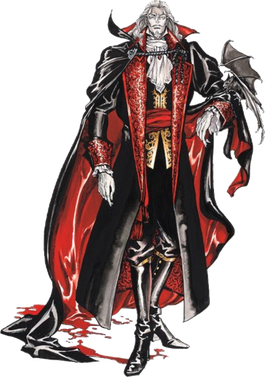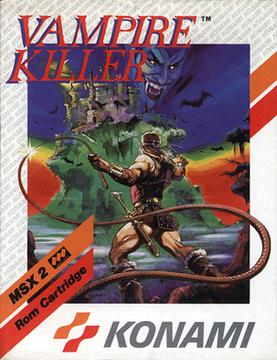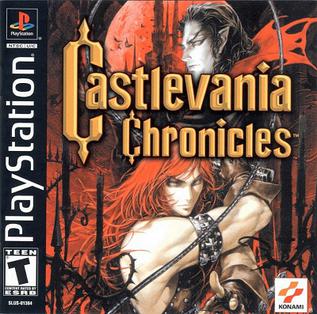
Castlevania, known in Japan as Akumajō Dracula, is a gothic horror action-adventure video game series and media franchise about Dracula, created and developed by Konami. It has been released on various platforms, from early systems to modern consoles, as well as handheld devices such as mobile phones. The franchise has expanded into several spin-off video games and other media, including comic books and an animated television series.

Castlevania: Lament of Innocence is a 2003 action-adventure game developed by Konami Computer Entertainment Tokyo and published by Konami for the PlayStation 2 console. Part of Konami's Castlevania video game series, it is the first installment of the series on the PlayStation 2 and the third to make use of a 3D style of gameplay. It was released in Japan and North America in late 2003 and Europe and Australia in early 2004.

Dracula Vlad Țepeș or simply known as Dracula, real name Mathias Cronqvist, is a fictional character from the Castlevania video game series created by Konami. A vampire and a sorcerer, he is the main antagonist of the series, the archenemy of the Belmont clan, and the final boss of almost every installment. In the series reboot Castlevania: Lords of Shadow, Dracula is reimagined as an 11th-century holy knight named Gabriel Belmont and serves as the central character of the game and its two sequels. The Lords of Shadow series tells the story of Gabriel's quest to save the world, fall into darkness, and journey of redemption.

Castlevania: Rondo of Blood, originally released in Japan as Akumajō Dracula X: Chi no Rondo, is a 1993 platform game developed by Konami for the PC Engine's Super CD-ROM² System directed by Toru Hagihara. Part of the Castlevania series, protagonist Richter Belmont goes to save his lover Annette, who was abducted by Dracula. It was first released exclusively in Japan on October 29, 1993. A direct sequel, Castlevania: Symphony of the Night, was released worldwide in 1997.

Castlevania: Circle of the Moon, titled Castlevania in PAL regions, is a 2001 action role-playing game created by Konami for the Game Boy Advance. Published as a launch title in 2001, Circle of the Moon is part of Konami's Castlevania video game series, the premise of which centers on the eternal conflict between the vampire hunters of the Belmont clan and the vampire Dracula. The game sold one million copies worldwide and was acclaimed by critics. The events of its plot were retconned by former Castlevania producer Koji Igarashi, a move which was met with some criticism.

Vampire Killer, known in Japan as Akumajō Dracula, is a 1986 platform game developed and published by Konami for the MSX2. It is a parallel version of the original Castlevania, which debuted a month earlier for the Famicom Disk System under the same Japanese title. However, the MSX2 version was localized first in Europe and was published without the Castlevania branding that the franchise would start using abroad in 1987 when the NES version was released in North America. It was released on the Wii U's Virtual Console on December 17, 2014 in Japan.

Castlevania III: Dracula's Curse is a 1989 platform game developed and published by Konami for the Nintendo Entertainment System. It was released in Japan in 1989, and in North America in 1990, and in Europe by Palcom in 1992. It was later released on the Virtual Console for the Wii, Nintendo 3DS, and Wii U.

Castlevania, also referred to as Castlevania 64, is a 1999 action-adventure game developed by Konami's Kobe branch for the Nintendo 64. An expanded version of the game, Castlevania: Legacy of Darkness, was released later in the same year.

Castlevania Legends is a 1997 platform game developed and released by Konami for the Game Boy. The third Castlevania game released for the system, the story follows Sonia Belmont, a vampire hunter battling the first incarnation of Count Dracula. The game was conceived as a prequel to all other games in the Castlevania series; however, it later became recognized as non-canon.

Super Castlevania IV is a 1991 platform game developed and published by Konami for the Super Nintendo Entertainment System. It has been re-released multiple times, including for the Super NES Classic Edition.

Castlevania: Dracula X, titled Castlevania: Vampire's Kiss in Europe, is a 1995 platform game developed and published by Konami for the Super Nintendo Entertainment System. It is the second Castlevania installment to be released for the Super NES. It is a remake of Castlevania: Rondo of Blood, which was previously released in Japan on the PC Engine Super CD-ROM2 in 1993. While the plot is similar to Rondo of Blood and it uses many of that game's graphics, it features new levels and altered gameplay elements, rather than being a direct port because of the limits of the Super NES cartridge format and exclusivity agreements with PC Engine maker NEC. It was released on July 21, 1995 in Japan, in September 1995 in North America, February 22, 1996 in Europe, and on June 22, 1996, in Australia. The game received mixed reviews, with journalists considering it inferior to Rondo of Blood and criticizing its high difficulty.

Haunted Castle is a 1987 platform game developed and released by Konami for arcades. It is the second arcade game in the Castlevania franchise, following Vs. Castlevania, an arcade port of the original 1986 NES video game released in North America. Unlike the previous arcade title in the franchise, Haunted Castle is not a direct port of an existing console game, but a newly-developed arcade game running on custom JAMMA-based board.

Castlevania Chronicles is a platform game compilation developed by Konami Computer Entertainment Tokyo for the PlayStation. It consists of two game modes: Original Mode, which is a port of the 1993 platform video game Akumajō Dracula for the X68000 home computer, and Arrange Mode, a modernized remake featuring a new introductory cinematic, new sprites, and re-balanced gameplay among other adjustments. The X68000 version of Akumajō Dracula is, itself, an updated remake of the original Castlevania for the NES, where the vampire hunter Simon Belmont must defeat Dracula and save Transylvania. The compilation was later released for the American and Japanese PlayStation Network as a PSone Classic in December 2008.
Akumajō Dracula is the Japanese name for the Castlevania video game series, as it is known worldwide. In Japan, several games within the series share the Akumajō Dracula name:

Castlevania: Order of Ecclesia is a 2008 action role-playing game and the third Nintendo DS installment of the Castlevania franchise. It was directed by Akihiro Minakata, with producer Koji Igarashi returning. The plot involves Shanoa, who is part of an organization set to defeat Dracula after the Belmont clan has vanished.

Castlevania Judgment is a 3D fighting video game developed by Eighting and published by Konami for the Wii. The game is based on the Castlevania series of games, and is the series' first fighting game.

Castlevania: The Arcade, released in Japan as Akumajō Dracula: The Arcade, is an arcade game, part of the Castlevania franchise by Konami. The game was announced on July 23, 2008. The game was released in Japan on October 2, 2009. A European release was announced for 2009 but only appeared at test locations in 2008.

Castlevania, known in Japan as Akumajō Dracula, is a 1986 platform game developed and published by Konami for the Family Computer Disk System. It was originally released in Japan in September 1986, before being ported to cartridge format and released in North America for the Nintendo Entertainment System (NES) in May 1987 and in Europe in 1988. It was also re-issued for the Family Computer in cartridge format in 1993. It is the first game in Konami's Castlevania video game series.

















